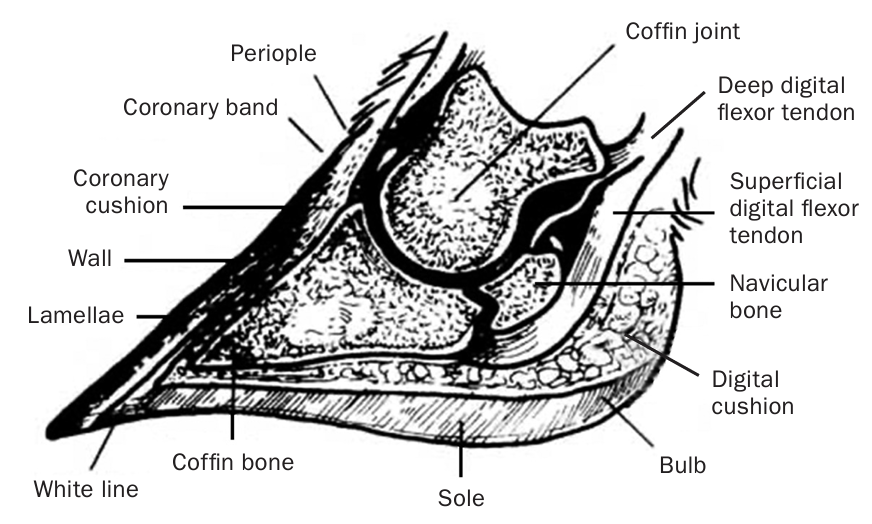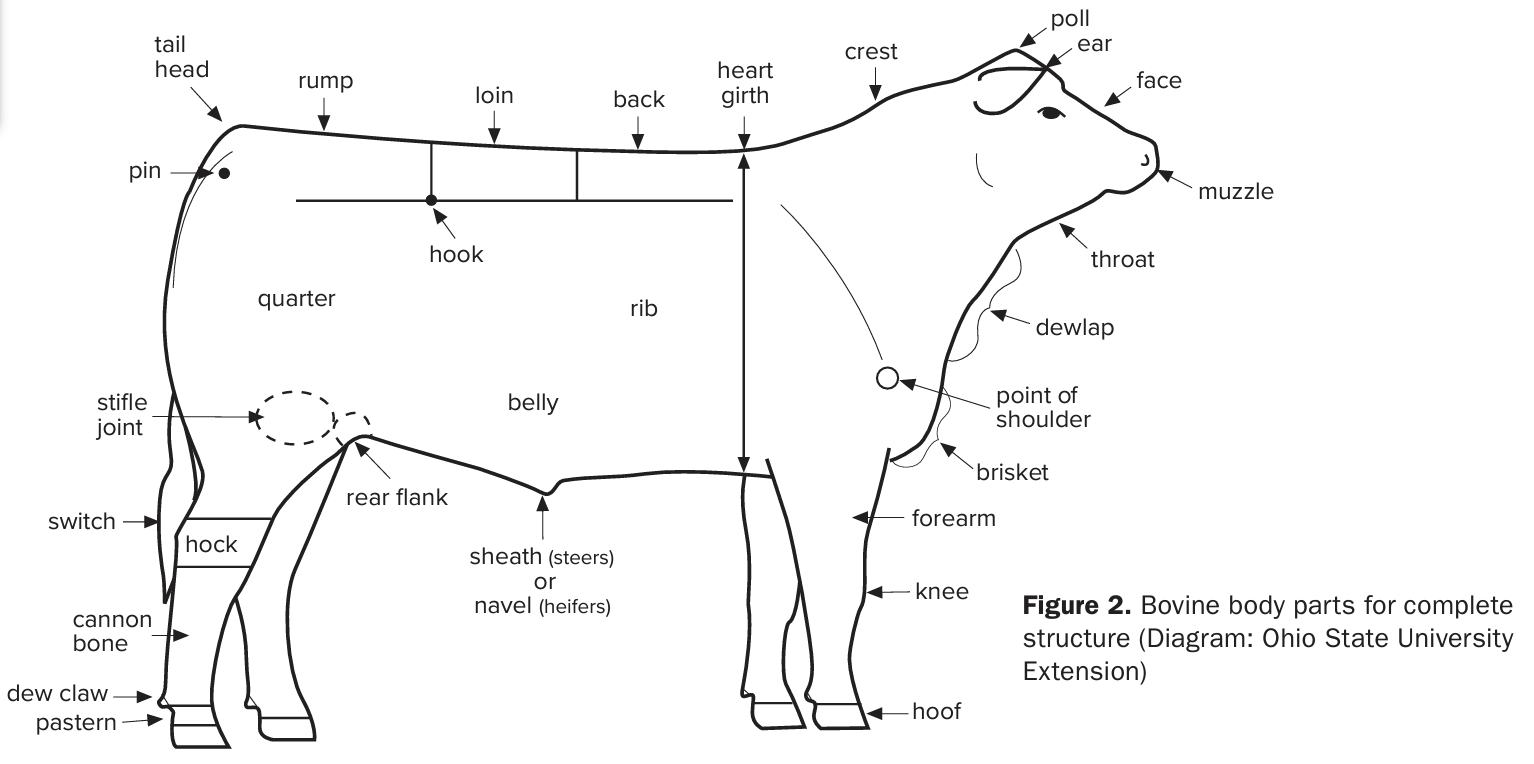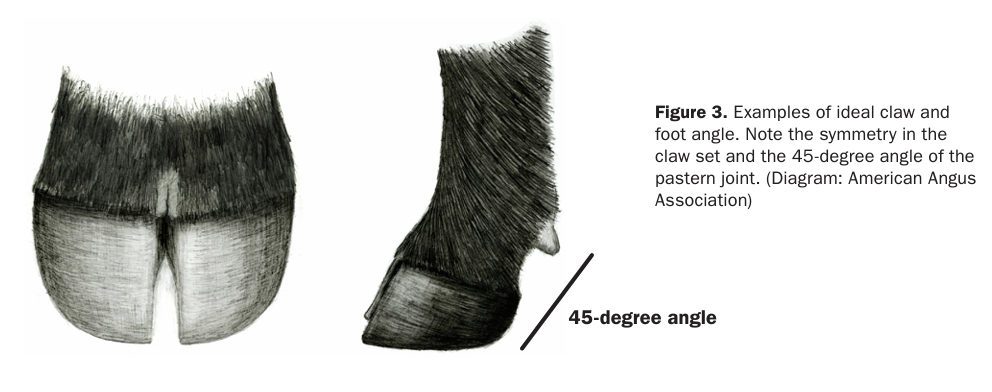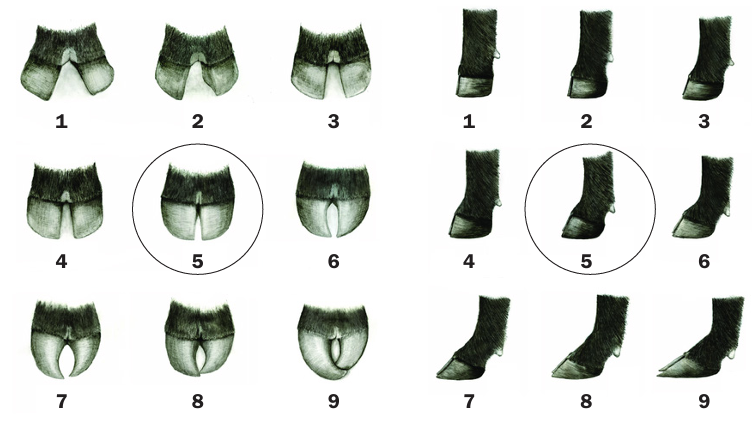Foot Scoring Beef Cattle
Agriculture and Natural Resources
MT202402AG
New May 2024
By Taylre Sitz, MS in Animal and Range Sciences from MSU; Tim DelCurto, MSU Professor and Nancy Cameron Endowed Chair; Megan Van Emon, MSU Extension Beef Cattle Specialist
Due to various selection pressures, beef cattle have been transformed in size and shape over the last 75 years. Increased demand for cattle performance may have inadvertently put extra stress on foot and leg structure. While some research has been performed in the dairy industry, limited work has been conducted in extensive beef production systems on foot and leg structure. Currently, the American Angus Association (AAA) is the only breed association that has established expected progeny differences (EPDs) for foot angle and claw set. The American Simmental Association, Red Angus Association, and American Gelbvieh Association are currently developing EPDs related to feet and leg structure as well. Therefore, information provided on foot scoring in this document will be based on the AAA guidelines.
Both the foot angle and claw set traits are critical to structural soundness, which can have long-lasting impacts on production and longevity in a herd. Structural soundness is important for cattle locomotion when grazing extensive rangeland systems. Therefore, the objective of this MontGuide is to provide information about scoring foot angle and claw set in beef cattle, which can be used to assess structural soundness.
The Bovine Foot
Cattle are even-toed ungulates, and each foot is comprised of two distal phalanges (medial and lateral) attached to the middle phalanx bone. Important anatomical points on the foot include the two toes (distal phalanges) collectively referred to as the claw set, the bulb (which is also referred to as the heel), and the sole or bottom of the foot (Figure 1).
The bovine hoof is made up of horn tissue and consists primarily of keratin. Hoof tissue grows approximately five millimeters per month in mature animals and slightly faster in calves. A 1986 study measured hoof growth and wear rates of Holstein cattle and concluded that front hooves grew and wore less than the rear hooves presumably due to greater weight distribution on the hind feet. Generally, keratin tissue production is impacted by season and nutrition, with the greatest rates during the summer months and lowest growth during winter.

Figure 1. Cross section of bovine foot (Ashwood, 2011); courtesy of Zinpro Corp.
Optimal Foot Conformation
Proper conformation is a function of many different, complex, anatomical parts working in synchronicity to allow an animal the ability of locomotion. Structural soundness and free locomotion are important for animals to cover acres of pasture for nutrition and breeding and are considered important factors in animal performance. When viewed from the rear, the legs of cattle should be equally as wide at the hocks and the pasterns (Figure 2) and animals should be able to walk straight forward, flexing at the hock. Joints of the animal should be well defined, and the feet should face straight forward with toes of even size and appropriate depth of heel. The idea is for the hooves to be straight enough to bear weight on the wall of the hoof and to have enough heel depth for the bulb to act as an appropriate shock absorber.

Figure 2. Bovine body parts for complete structure (Diagram: Ohio State University Extension)
Ideally, the slope of the pastern joint is 45° to 47° and animals deviating significantly from a 45° angle from their toe to the pastern joint can face structural consequences. Straightlegged, or post-legged animals often have a short, choppy stride resulting from restricted mobility and are at a greater risk of injury (e.g., lameness, stifle, bone fractures), especially during breeding. Alternatively, animals that are referred to as sicklehocked or weak-pasterned have an anatomical condition where the feet are forced further under the body, thus putting more strain on the muscle and bones of the stifle and hip region (Figure 2), at least in the case of the hind legs. This could result in hoof growth exceeding wear in regions with softer terrain surfaces, thus overextending the coffin joint and tensing the deep digital flexor tendon. This alteration in foot angle results in a greater weight-bearing load on the navicular bone, often causing pain and lameness. It is important to remember that conformation of the limb is affected by various joint angles and conformation of the body as a whole as well as selection pressures placed on these animals. Ultimately, producers strive to select animals with ideal foot and leg structure (Figure 3).

Figure 3. Examples of ideal claw and foot angle. Note the symmetry in the claw set and the 45-degree angle of the pastern joint. (Diagram: American Angus Association)
Foot conformation and structure are impacted by several factors, such as infection, trauma, age, nutrition, environment and genetics. Foot structure changes as animals age, so as data is submitted to breed associations, age adjustments are included. Previous research has determined that foot conformation is moderately heritable for yearling-age Angus cattle (0.16 to 0.37, where a score of 1.0 is completely heritable).
Foot Angle and Claw Set Scoring
The AAA developed a foot scoring guideline for members to score both foot angle and claw set on a 1–9 scoring system (Figure 4). A score of 5 for both claw set and foot angle indicates ideal conformation: claw set is symmetrical with proper length of toes, and pastern angle is approximately 45 degrees with appropriate heel depth. For the claw set, as the score moves toward 1, the animal’s claw set becomes more divergent. As it moves toward 9, the claws are becoming more curled and “scissor” like, perhaps with variations in claw size and claws even crossing over one another. With foot angle, as the score moves toward 1, the animal’s pastern angle becomes more obtuse, resulting in “post-legged” animals. Moving toward a foot angle score of 9, the pastern angle becomes more acute, resulting in animals with their hooves set further forward and becoming weak-pasterned or sickle-hocked.

Figure 4. Foot score sketches characterizing claw scores (left) and pastern angles (right). A score of 5 for both claw set and foot angle indicates ideal conformation. (Diagram: American Angus Association)
Guidelines for Foot Scoring
The current guidelines from the AAA are:
- Scores should be taken prior to foot trimming, if foot trimming occurs.
- Cattle must be at least 320 days of age at the time of scoring.
- Identify and score foot angle and claw set on the combined worst foot on each animal.
- Cattle should be scored on a hard, flat surface where the feet can be easily visualized. Scoring should not take place while cattle are in a chute as they do not stand naturally.
- Scoring on females is recommended annually.
- The same technician should score the entire scoring event or contemporary group to reduce bias.
Foot Scoring Resources: How-To's and More Information
- AAA Foot Scoring Guidelines and Recommendations www.angus.org/performance/Documents/ footscorebrochure.pdf
- AAA Foot Scoring YouTube videos www.youtube.com/@AngusAssoc/featured
Tips for Adding Foot Scoring to Already Scheduled Cow Working Events
- Look through the foot scoring resources and learn about the process. Videos can provide helpful practice at foot scoring alongside the experts.
- Consider designating a foot-scorer. Give the scorer the time, space, and a hard, flat surface to score feet for the most representative foot scores for the cow herd.
- Ensure there is a place to conduct foot scoring on a flat and even surface. This could be a concrete or dry dirt/ gravel alley, or even rubber mats in front of the chute.
- Prepare a list or a notebook and pre-determine the format for collecting foot scores. Consider how the scores will be utilized.
General Considerations
Foot angle and claw set EPDs are two relatively new progeny measurements. The most accurate EPDs have both phenotypic and genomic data submitted on progeny. Many breed associations are developing EPDs for feet and leg structure. The success of this EPD will depend upon acceptance by commercial cattlemen as a selection tool and the continued collection of foot scores by breeders. Foot angle and claw set scores can be taken on both commercial and seedstock cattle. Livestock producers of any breed can use the information provided from the AAA to assess the foot and leg structure of their animals. Utilizing pastern angle and claw set EPDs and collecting annual foot scores in a herd should be a central part of management for improved feet and leg conformation in a cow herd.
References
Ashwood, A. Structure and Lameness. In Brahman News; Australian Brahman Breeders’ Association Limited: Rockhampton, QLD, Australia, 2011.
Beeson, W.M.; Hunsley, R.E.; Nordby, J.E. Beef Cattle. In Livestock Judging and Evaluation: A Handbook for the Student; INTERSTATE Printers & Publishers Inc.: The Danville, IL, USA, 1970.
Boggs, D.L.; Merkel, R.A.; Doumit, M.E.; Bruns, K. Livestock & Carcasses: An Integrated Approach to Evaluation, Grading, and Selection, 6th ed.; Kendall/Hunt Publishing Company: Dubuque, IA, USA, 2006; p. 251.
Daniel, D.L., Jr.; Kriese-Anderson, L. Beef Conformation Basics; Alabama A&M & Auburn Universities Extension: Huntsville, AL, USA, 2018.
Dyce, K.M.; Sack, W.O.; Wensing, C.G. Textbook of Veterinary Anatomy, 4th ed.; Saunders: St. Louis, MO, USA, 2010.
Greenough, P.R.; Finlay, J.; Weaver, A. Lameness in Cattle, 2nd ed.; John Wright PSG Inc.: Littleton, MA, USA, 1981.
Hahn, M.V.; McDaniel, B.; Wilk, J. Rates of hoof growth and wear in Holstein cattle. J. Dairy Sci. 1986, 69, 2148–2156.
Langova, L.; Novotna, I.; Nemcova, P.; Machacek, M.; Havlicek, Z.; Zemanova, M.; Chrast, V. Impact of Nutrients on the Hoof Health in Cattle. Animals 2020, 10, 1824.
Tranter, W.; Morris, R. Hoof growth and wear in pasture-fed dairy cattle. N. Z. Vet. J. 1992, 40, 89–96.
Wang, L.; Miller, S.P.; Retallick, K.J.; Moser, D.W. Genetic parameter estimation for foot structure in American Angus cattle. J. Anim. Sci. 2017, 95, 100.
Wheeler, J. Hoof growth: A possible index of nutrition in grazing animals. Proc. Aust. Soc. Anim. Prod. 1966, 6, 350–353.
Wolfe, D.F. Review: Abnormalities of the bull – Occurrence, diagnosis and treatment of abnormalities of the bull, including structural soundness. Animal 2018, 12, s148s157.
To download more free online MontGuides or order other publications, visit our online catalog at store.msuextension.org, contact your county or reservation MSU Extension office, or e-mail orderpubs@montana.edu.
Copyright © 2024 MSU Extension We encourage the use of this document for nonprofit educational purposes. This document may be reprinted for nonprofit educational purposes if no endorsement of a commercial product, service or company is stated or implied, and if appropriate credit is given to the author and MSU Extension. To use these documents in electronic formats, permission must be sought from the Extension Communications Director, 135 Culbertson Hall, Montana State University, Bozeman, MT 59717; E-mail: publications@montana.edu
The U.S. Department of Agriculture (USDA), Montana State University and Montana State University Extension prohibit discrimination in all of their programs and activities on the basis of race, color, national origin, gender, religion, age, disability, political beliefs, sexual orientation, and marital and family status. Issued in furtherance of cooperative extension work in agriculture and home economics, acts of May 8 and June 30, 1914, in cooperation with the U.S. Department of Agriculture, Cody Stone, Director of Extension, Montana State University, Bozeman, MT 59717.

